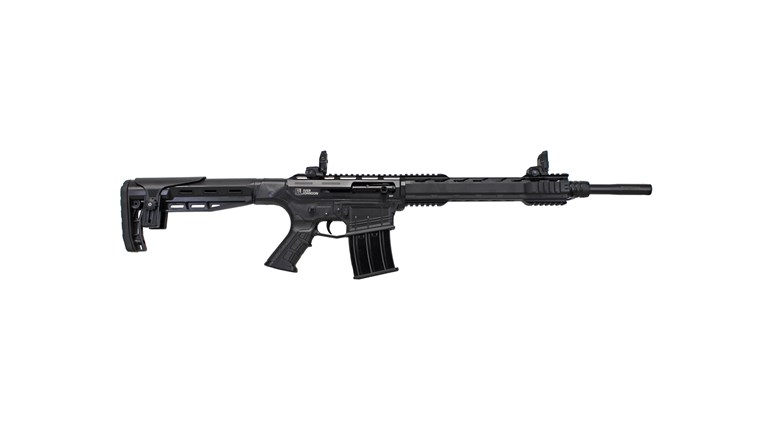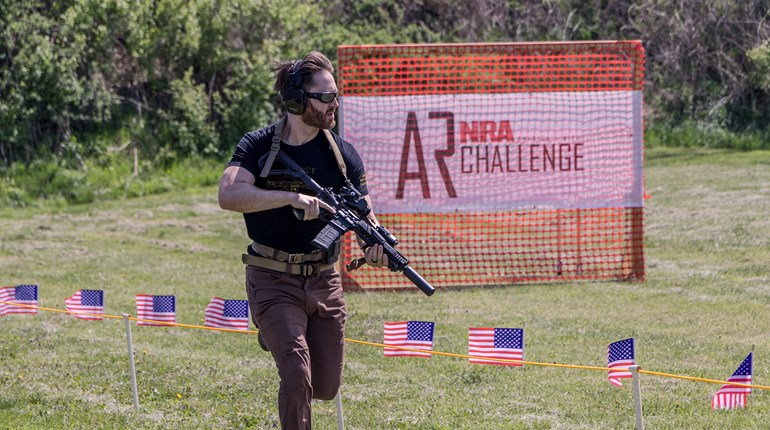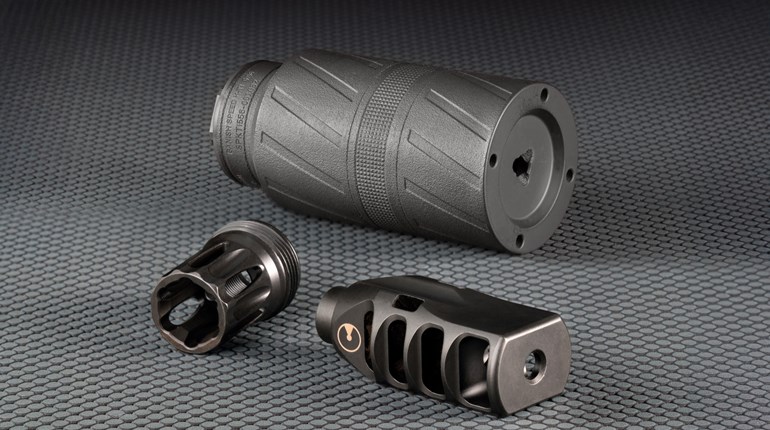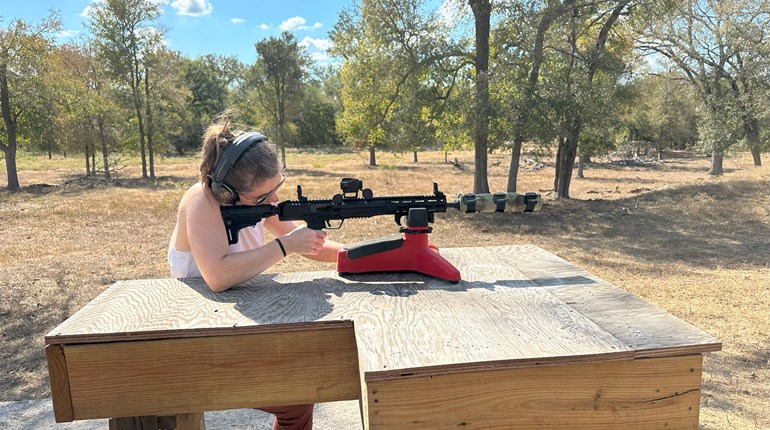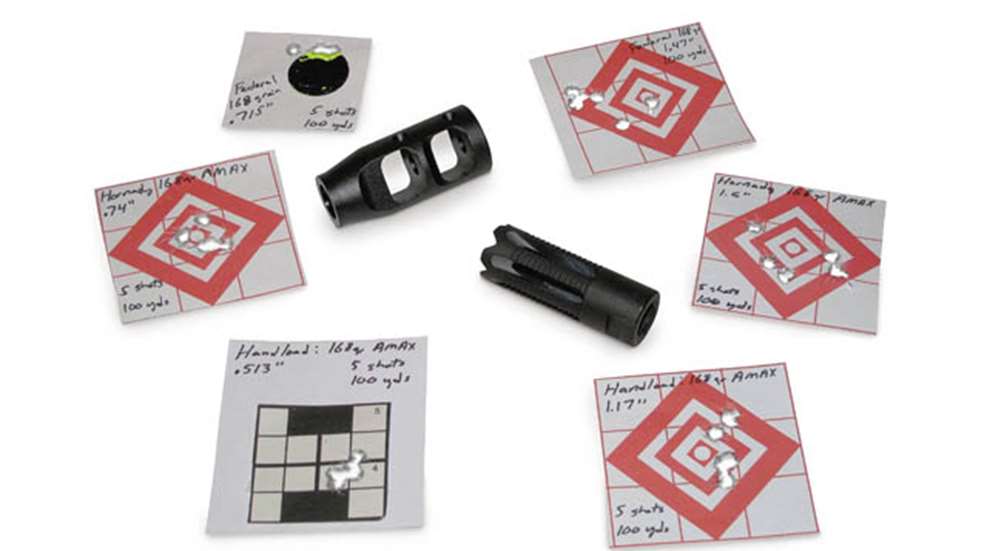
While I've incorporated combination flash hider/brakes on several carbines, as with all compromises, they don't perform both functions as well as desired. One exception to my preference for flash management is with heavier-recoiling .338 Lapua Mag. and .50 BMG rifles. In those cases, braking recoil for comfort and accuracy is a necessity. The latter benefit should have made a larger impact on me, and the fact I'm only now realizing how well braking helps accuracy is evidence of my slow-wittedness.
Several 5.56 NATO and .308 Win. rifles I recently built had threaded (aka pre-ban) barrels that were destined for accurate pursuits. Normally, I'll recommend a bull barrel when premium performance is desired, and there are solid reasons for this advice. But when a shooter wants or needs greater reductions of flash, muzzle movement or both, a decision has to be made about what type of muzzle device to use. One particular 5.56 rifle wore a heavy-contour (.936-inch outer diameter) barrel, so I opted for a JP Enterprises/Bennie Cooley tactical muzzle brake, which blended nicely with the large barrel. I had previously tested the JP brake on one of the company's LRP-07 (.308 Win.) rifles and remembered it was effective at taming felt recoil, but I never gave it further thought. However, when I installed the 5.56 version on the rifle I built, I noticed felt recoil was reduced to the level of a .22 LR. The brake forced the rifle to move straight to the rear during recoil, so the scope's reticle essentially remained on point of aim as long as my body position was correct. Braking a small-bore rifle isn't a comfort issue, it's all about accuracy. A well-controlled muzzle will yield very nice performance downrange. When this 18-inch-barreled AR was finished, it averaged .9-inch groups at 100 yards overall. While that number isn't astounding for a rifle's favored load, in this case it was the average for all ammo I fed it. Its preferred ammo types printed in the .6- to .7-inch range.
I've built rifles that shoot better with their favored load, but none that shot all factory match loads this well. After seeing this performance, I started to piece together snapshots from past long-gun experiences.
I purchased my first AR during that "golden" era when muzzle brakes had to be permanently attached to rifles. Mine was a pinned and welded baffle-style brake that resembled a to-scale version of those I'd seen on artillery pieces. At the time, my Army-issued M4 carbine had the familiar A2-style combination flash suppressor/muzzle brake that performs neither task well. The first thing I noticed with my pinned brake was that recoil was straight back, allowing very rapid follow-up shots. Accuracy was also very good for a stock carbine.
Last year, I built a pair of custom rifles for 3-gun incorporating Jerry Miculek's simple-but-effective muzzle brakes on both. I found the same benefits, with each shooting .75-inch groups at 100 yards with excellent muzzle control. Once I discovered how well the smaller JP brake worked, I decided to attack a .308 accuracy problem I'd been wrestling with.
During the same time frame, I also accurized a stock DPMS Panther 7.62 NATO Sportical carbine. Upon completion, I had a two-upper system, consisting of the original 16-inch barrel for basic ranch-rifle duties and an 18-inch-barreled upper that sends rounds wherever you want, all day long. No matter how hard I tried, I couldn't seem to get the 18-inch upper to shoot consistently decent groups. Each accurization technique I tried brought group averages down incrementally, but not to the degree I've achieved with other .308s. I was about to give up—assuming the longer barrel I'd gambled on was a dog. No matter how solid my shooting position, muzzle movement after each shot was significant, so I began to suspect recoil was having more affect on accuracy than previously thought. This is no flyweight rifle. The 18-inch barrel is a heavy-contour, fluted, stainless steel affair and combined with the brake and a full-length, quad-rail free-float handguard, it is not fun to carry around for long periods. Yet, the muzzle simply wouldn't settle down. I decided to order a .308 brake from JP and the results were eye opening. The once-mediocre upper now shoots steady .5-inch groups at 100 yards with its best fodder, and .5 to .75 inch with most other match loads I feed it. Changing from a flash suppressor to a truly effective muzzle brake made the most difference in the end.
However, compensators and muzzle brakes do come with baggage, which is why I largely ignored them for so long. For tactical shooters whose firing positions must remain concealed, effective brakes are usually a liability. Not only do they tend to throw copious flash out from ports and baffles, but the blast that follows throws enough dust and vegetation that spotting a shooter is relatively easy. If you're in a position where controlling flash and recoil are both important, one of the combination brakes might be worth a look. If you're like me and no longer have those worries, giving a good quality muzzle brake a try just might give you something to brag about the next time you compare groups. While they aren't likely to fix a bad barrel, chances are they'll positively influence the shooter/rifle interface well enough to see tangible results downrange.












